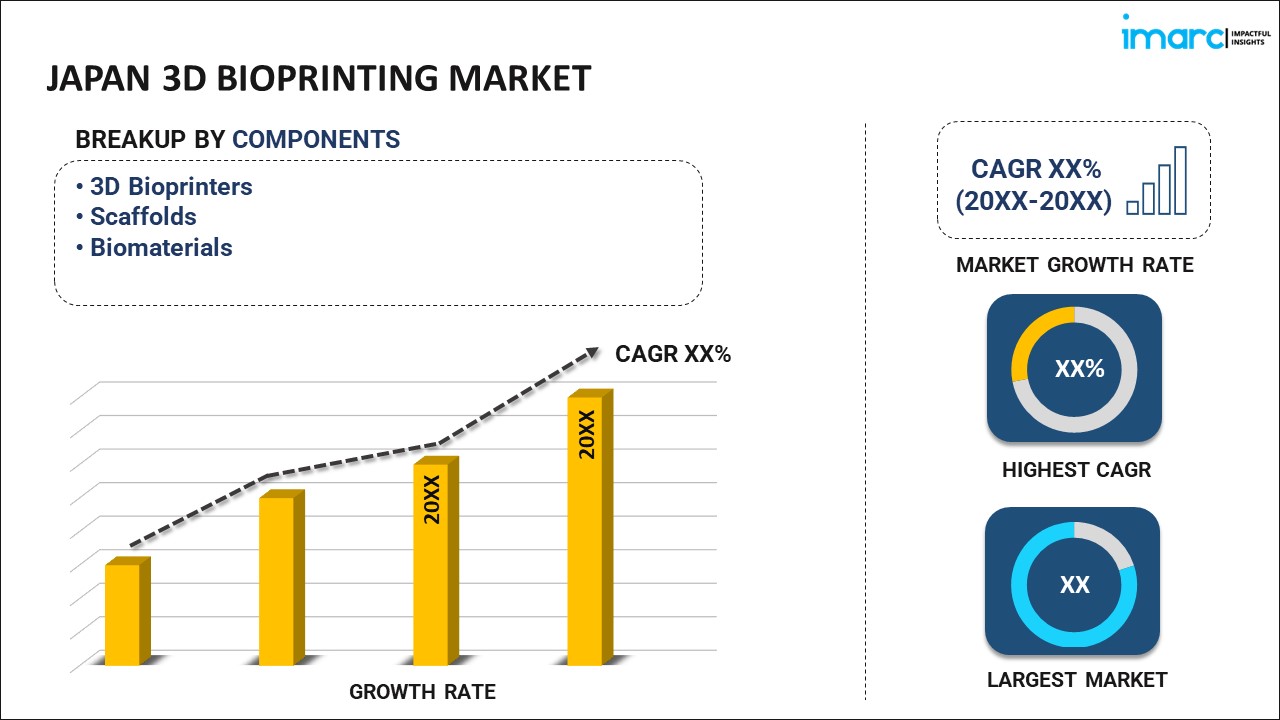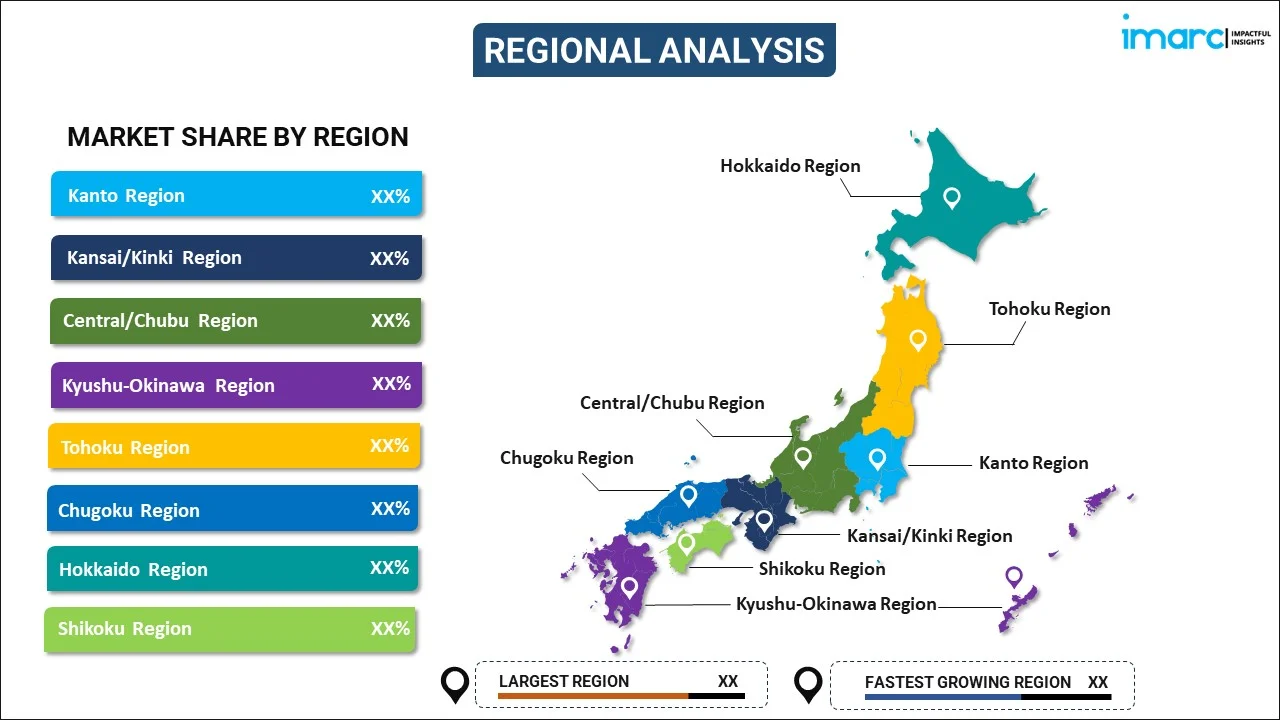
Japan 3D Bioprinting Market Report by Component (3D Bioprinters, Scaffolds, Biomaterials), Application (Research, Clinical), End User (Hospitals, Research Organization and Academic Institutes, Biopharmaceuticals Companies), and Region 2025-2033
Market Overview:
Japan 3D bioprinting market size reached USD 82.9 Million in 2024. Looking forward, IMARC Group expects the market to reach USD 316.7 Million by 2033, exhibiting a growth rate (CAGR) of 16.1% during 2025-2033. The elevating need for organ transplantation among the geriatric population, along with the easy access to medical technologies, is primarily driving the market growth.
|
Report Attribute
|
Key Statistics
|
|---|---|
|
Base Year
|
2024 |
|
Forecast Years
|
2025-2033 |
|
Historical Years
|
2019-2024
|
| Market Size in 2024 | USD 82.9 Million |
| Market Forecast in 2033 | USD 316.7 Million |
| Market Growth Rate (2025-2033) | 16.1% |
Three-dimensional (3D) bioprinting is an additive manufacturing technique developed for the precise fabrication of anatomical tissues. This method encompasses various deposition and assembly processes, including direct and laser writing, microstamping, photolithography, stereolithography, electro-printing, and inkjet deposition. In addition to this, it relies on the layer-by-layer assembly of cell-based bio-inks, which are formulated using living cells, biomaterials, and active biomolecules, to construct 3D tissue and organ structures. By depositing multiple layers of biomaterials, 3D bioprinting can create complex bodily structures such as bones, skin, cartilage, vascular grafts, tracheal splints, and heart tissues. Consequently, it finds extensive applications in hospitals, research institutions, academic establishments, and biopharmaceutical companies across Japan.
Japan 3D Bioprinting Market Trends:
In the context of the Japan market, the increasing emphasis on reducing animal testing is a significant factor positively influencing the industry. Additionally, the rising demand for 3D bioprinting, particularly among the elderly population who are more susceptible to various chronic illnesses, is fostering a favorable market outlook, thereby acting as another significant growth-inducing factor. Besides this, technological advancements such as the development of organ-on-a-chip systems are also driving market growth. Furthermore, the surging global demand for regenerative medicines, cancer therapeutics, and stem cell solutions is contributing to the expansion of the market. Apart from this, the healthcare sector in Japan is increasingly adopting 3D bioprinting, and its relatively lower disruption level compared to other industries is providing substantial support to market growth. Moreover, prominent manufacturers are placing a strong focus on research and development (R&D) activities aimed at introducing bio printed tissues, which is positively influencing the regional market. This effort aims to reduce the cost associated with new innovations and streamline the drug discovery process, further propelling advancement within Japan. All these above mentioned factors are expected to catalyze the market growth over the forecasted period.
Japan 3D Bioprinting Market Segmentation:
IMARC Group provides an analysis of the key trends in each segment of the market, along with forecasts at the country level for 2025-2033. Our report has categorized the market based on component, application, and end user.
Component Insights:

- 3D Bioprinters
- Syringe/Extrusion Bioprinting
- Inkjet Bioprinting
- Magnetic Levitation Bioprinting
- Laser-assisted Bioprinting
- Others
- Scaffolds
- Biomaterials
- Living Cells
- Hydrogels
- Extracellular Matrices
- Others
The report has provided a detailed breakup and analysis of the market based on the component. This includes 3D bioprinters (syringe/extrusion bioprinting, inkjet bioprinting, magnetic levitation bioprinting, laser-assisted bioprinting, and others), scaffolds, and biomaterials (living cells, hydrogels, extracellular matrices, and others).
Application Insights:
- Research
- Drug Research
- Regenerative Medicine
- 3D Cell Culture
- Clinical
- Skin
- Bone and Cartilage
- Blood Vessels
- Others
A detailed breakup and analysis of the market based on the application have also been provided in the report. This includes research (drug research, regenerative medicine, and 3D cell culture) and clinical (skin, bone and cartilage, blood vessels, and others).
End User Insights:
- Hospitals
- Research Organization and Academic Institutes
- Biopharmaceuticals Companies
The report has provided a detailed breakup and analysis of the market based on the end user. This includes hospitals, research organization and academic institutes, and biopharmaceuticals companies.
Regional Insights:

- Kanto Region
- Kansai/Kinki Region
- Central/ Chubu Region
- Kyushu-Okinawa Region
- Tohoku Region
- Chugoku Region
- Hokkaido Region
- Shikoku Region
The report has also provided a comprehensive analysis of all the major regional markets, which include Kanto Region, Kansai/Kinki Region, Central/ Chubu Region, Kyushu-Okinawa Region, Tohoku Region, Chugoku Region, Hokkaido Region, and Shikoku Region.
Competitive Landscape:
The market research report has also provided a comprehensive analysis of the competitive landscape. Competitive analysis such as market structure, key player positioning, top winning strategies, competitive dashboard, and company evaluation quadrant has been covered in the report. Also, detailed profiles of all major companies have been provided.
Japan 3D Bioprinting Market Report Coverage:
| Report Features | Details |
|---|---|
| Base Year of the Analysis | 2024 |
| Historical Period | 2019-2024 |
| Forecast Period | 2025-2033 |
| Units | Million USD |
| Scope of the Report | Exploration of Historical Trends and Market Outlook, Industry Catalysts and Challenges, Segment-Wise Historical and Future Market Assessment:
|
| Components Covered |
|
| Applications Covered |
|
| End Users Covered | Hospitals, Research Organization and Academic Institutes, Biopharmaceuticals Companies |
| Regions Covered | Kanto Region, Kansai/Kinki Region, Central/ Chubu Region, Kyushu-Okinawa Region, Tohoku Region, Chugoku Region, Hokkaido Region, Shikoku Region |
| Customization Scope | 10% Free Customization |
| Post-Sale Analyst Support | 10-12 Weeks |
| Delivery Format | PDF and Excel through Email (We can also provide the editable version of the report in PPT/Word format on special request) |
Key Questions Answered in This Report:
- How has the Japan 3D bioprinting market performed so far and how will it perform in the coming years?
- What has been the impact of COVID-19 on the Japan 3D bioprinting market?
- What is the breakup of the Japan 3D bioprinting market on the basis of component?
- What is the breakup of the Japan 3D bioprinting market on the basis of application?
- What is the breakup of the Japan 3D bioprinting market on the basis of end user?
- What are the various stages in the value chain of the Japan 3D bioprinting market?
- What are the key driving factors and challenges in the Japan 3D bioprinting?
- What is the structure of the Japan 3D bioprinting market and who are the key players?
- What is the degree of competition in the Japan 3D Bioprinting market?
Key Benefits for Stakeholders:
- IMARC’s industry report offers a comprehensive quantitative analysis of various market segments, historical and current market trends, market forecasts, and dynamics of the Japan 3D bioprinting market from 2019-2033.
- The research report provides the latest information on the market drivers, challenges, and opportunities in the Japan 3D bioprinting market.
- Porter's five forces analysis assist stakeholders in assessing the impact of new entrants, competitive rivalry, supplier power, buyer power, and the threat of substitution. It helps stakeholders to analyze the level of competition within the Japan 3D bioprinting industry and its attractiveness.
- Competitive landscape allows stakeholders to understand their competitive environment and provides an insight into the current positions of key players in the market.
Need more help?
- Speak to our experienced analysts for insights on the current market scenarios.
- Include additional segments and countries to customize the report as per your requirement.
- Gain an unparalleled competitive advantage in your domain by understanding how to utilize the report and positively impacting your operations and revenue.
- For further assistance, please connect with our analysts.
 Inquire Before Buying
Inquire Before Buying
 Speak to an Analyst
Speak to an Analyst
 Request Brochure
Request Brochure
 Request Customization
Request Customization




.webp)




.webp)












